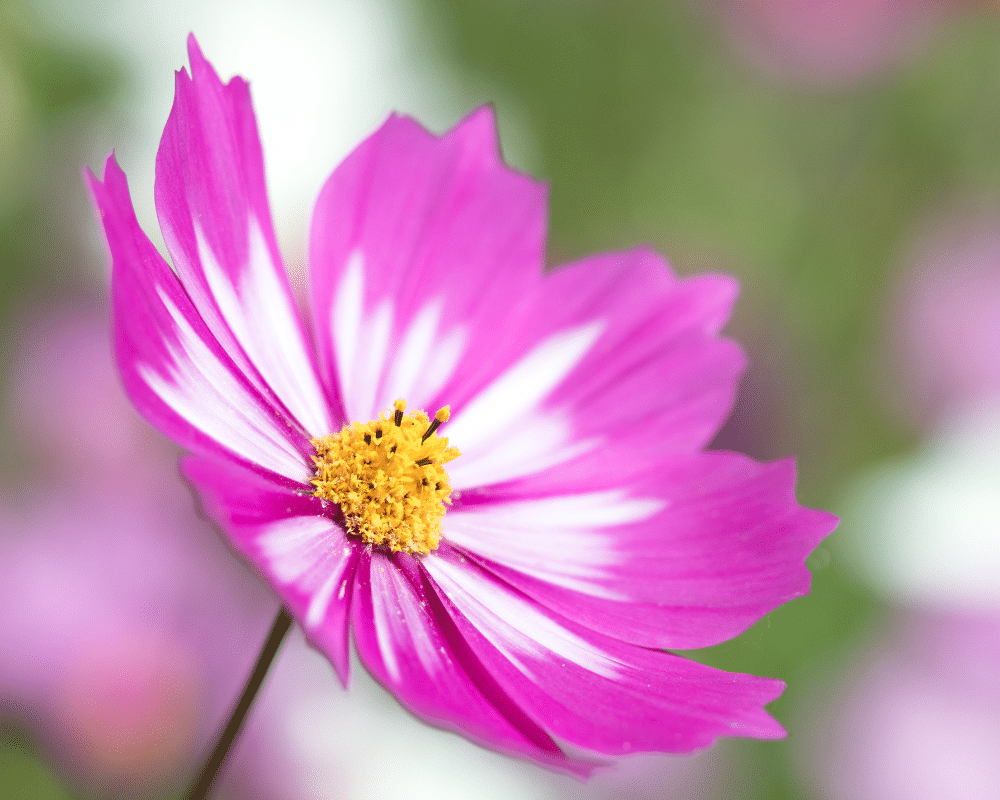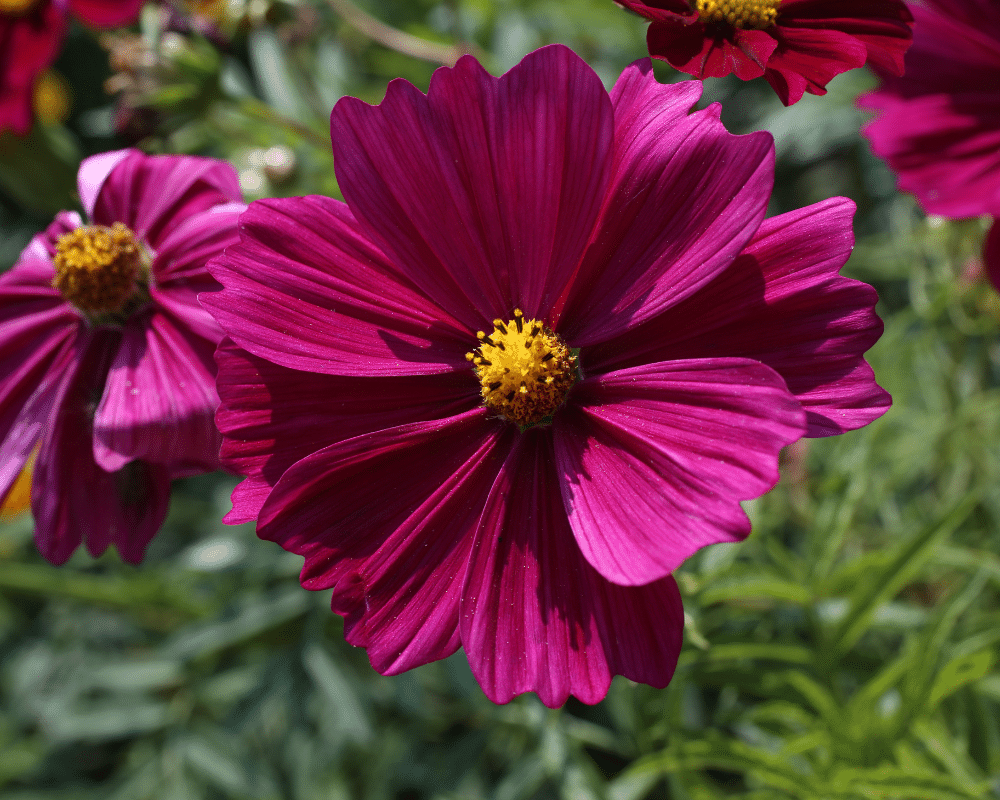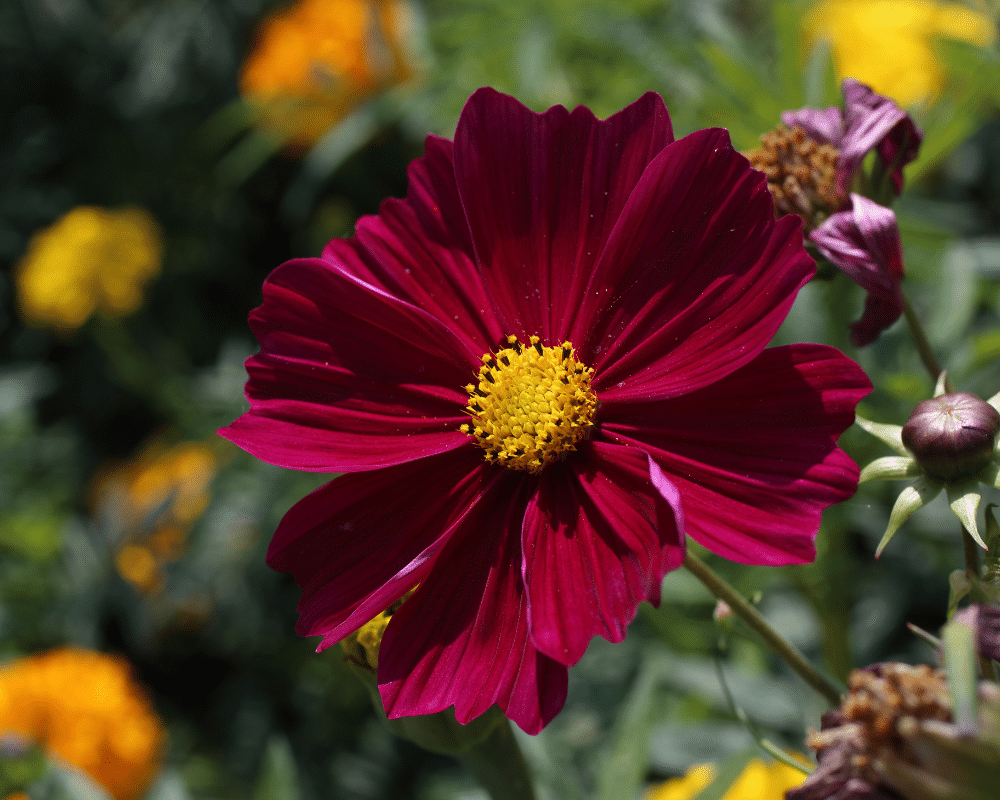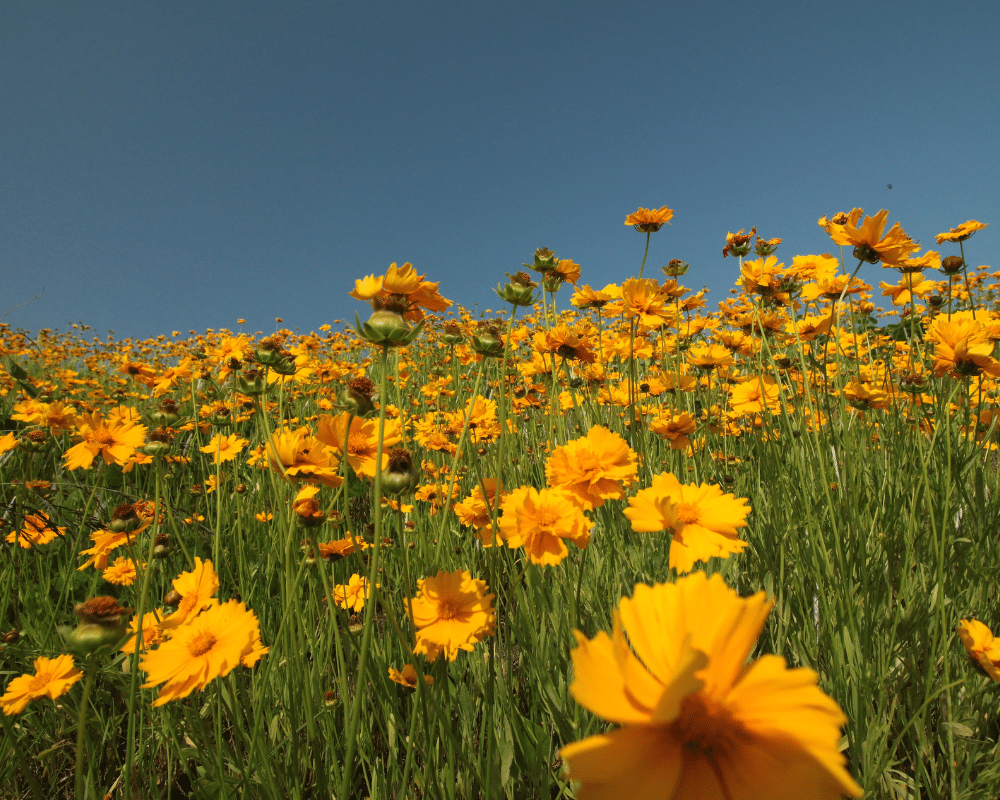Does your garden area include a place like this? Poor soil, lots of sun, too little time? Would you like beautiful flowers that like poor soil all summer long? Look into Cosmos, with lovely colors to choose from.
The cosmos is an annual flower that will bring you colorful, somewhat daisy-like flowers in vibrant colors. They are a solution for spaces on your property with harsh growing conditions. Expect large flowers in flat, cup-like or bowl-shaped, some will reach four inches in diameter. They will help you to create an eye catcing meadow from otherwise arid places.
Cosmos will attract birds, bees, and butterflies to your garden.
Ways To Use Cosmos
- They are excellent cut flowers
- Pollinator attractors
- A Ground cover for barren areas
- A distant view
Cosmos bipinnatus-the Mexican Aster

Beautiful flowers all summer long, they include varied sizes, from 1′ to 6′ tall. Cosmos is a superior cutting flower, perhaps the highest volume of blossoms per foot of any cut flower plant. Reasonably drought-resistant and not in need of fertile soil or fertilization. Low in labor. They start to bloom after the spring blossoms have gone and last until frost.
How To Use Cosmos-They Love Poor Soil
Cosmos provide high flower volume and a wide range of heights. This gives us some special opportunities we don’t have with other plants. Here are some:
- In many parts of borders and planting beds. With sizes ranging from 12″ to 6,’ Cosmos can be used from the front through the center and the back of the flower bed.
- Cut flowers, Cosmos provide a very high volume of flowers and they can last in the vase for more than one week. The variety of colors and sizes of blossoms is excellent.
- The flower is attractive to birds and pollinators, you can enjoy wildlife in the garden.
- It is considered unattractive to deer. (Rabbits, however, not so much, they will munch.)
- They can be used in fields and meadows where other flowers will not grow.
- They require less water and fertilizer than most of our other garden annuals. This allows us to beautify hard-to-garden areas.
- Cosmos is an excellent dried flower. This is a link to an agricultural university site with instructions for drying flowers.
- Use them to plug gaps in borders
Cosmos For Pollinators

You can use your collection of Cosmos flowers to attract and support pollinators. Bees are in global decline, and our gardens can provide them with a healthy diet, and of course, we benefit from their help to our food chain. Larger butterflies such as the Monarch appreciate flat flowers they can land on, and you will enjoy them in your garden. In addition, birds that live in or migrate through your area will show up for your entertainment.
Where Did We Get Cosmos?
Spanish monks found this charming flower in Mexico and used it in Missionary gardens. It is native to much of the Americas, ranging from North America to as far north as Washington. It also lives in Central and South America, as far south as Paraguay. The pretty flower has traveled with people and is now naturalized in places as diverse as Italy, the West Indies, South Africa, and Asia.
These monks led adventurous and rough lives, but they did have classical educations. They found the regular form of the flower to be harmonious. They gave it the Greek word for order and harmony in the universe.
Native Areas for Cosmos
Areas of Southern North America, Central America, and Northern South America. In some areas of Southern North America the plant can be invasive. Check with your local county extension service and best local garden centers. You can use them in containers in these cases.
What Are The Plants We Are Using?
Cosmos bipinnatus

This is the Mexican Aster, the plant with pink, white, and dark rose colors and the fern-like foliage we enjoy. Specific varieties include these: Dazzler, Gazebo Red, Fizzy Pink, Picotee, and Sonata White.
Cosmos sulphures
The flowers are red, yellow, and orange with the same fern-like foliage. Specific varieties include the following: Klonkyke Mix, Polydor, Ladybird Dwarf Red, Ladybird Dwarf Gold, Ladybird Dwarf Orange, and Ladybird Dwarf Lemon.
Cosmos atrosarguineus
This is called the “chocolate cosmos” and is not one of the annual varieties. It has a corm somewhat like a Dahlia and is a warm climate perennial. (With heavy mulch, it may survive in the ground as far north as zone 7-8.) Its color is called chocolate, but it is a handsome dark red. They grow to about 23-30″ and are recommended for containers as well as bedding areas.
Some Varieties To Grow
These are varieties of the annual Cosmos.
| COSMOS VARIETY | FEATURES |
| Cosmic Orange | a very bright, clear orange. Considered quite drought-tolerant |
| Peppermint Candy | splashes of white and magenta |
| Picotee | 3-5′ high, crimson flower, can take part shade |
| Purity | White, saucer-shaped blossom |
| Sea Shells | Pink, red, rose, carmine blossom in curved petals |
| Sonata | as large as 3′ across, dwarf, to 2-3′. Red, white, pink, plum. For garden or container. |
Wildlife For Your Garden
Cosmos will attract birds, bees, and butterflies to your garden. Among the birds, look for white-throated sparrows, mourning doves, and Amerian goldfinches. You will see Monarchs and Pink Ladies. The Cosmos flower has many color choices, and the nectar is rich.
Growing Cosmos: In Poor Soil, Bright Sun, Benign Neglect

Planting
Cosmos can be grown from the garden center’s small plants or seeds. Plant the seeds about 18″ apart and press the seed into the soil. Do not cover the seed. Flowers will take about 7 weeks to appear. Rich soil, fertilizer, and extensive watering are not needed. Rich soil with plenty of organic amendments will produce lush foliage but fewer flowers.
Soil For Cosmos
Save the cosmos for your poorer soil, they will not perform in rich soil, here you will achieve tall and floppy plants. They will accept poor and dry soil, will perform best in well-drained soil with medium moisture. The best pH is neutral, ranging from 6.0-8.0.
Sun Conditions
Cosmos will perform best in bright full sun conditions, they will accept more harsh sunlight than many other plants. In fewer hours of sun the plant will survive but with less flower color.
Water and Fertilizer
Water
Water the new plants well, and add mulch to retain water as they develop. The mature plants can accept dry soil. Water, but do not overwater the flowers. Over-watered cosmos will develop foliage but few blossoms.
Fertilizer
Add a small amount of fertilizer to the soil when planting. Avoid nitrogen or even a balanced fertilizer which will encourage foliage at the expense of flowers. Use a bloom fertilizer. You should not require fertilizer again if the plant is growing normally.
Maintenance
Staking: Cosmos have thick hollow stems, and the taller variety may be damaged by heavy wind and rain. Staking them can save losses during the summer storms. Recently, I watched one expert use a bamboo stake and a loop of garden twine to encircle each entire plant. Keep the loop large enough to retain the full shape of the plant. I like the plastic tape, which has a little flexibility to prevent damaging the plants.
Deadheading– deadheading will prevent the plant from setting seeds and instead produce flowers. Take the complete flowerhead, including the tiny “leaves” at its bottom. Otherwise, the plant will create seeds, which is, of course, the beginning of its decline.
Pests and Diseases
Pests- Aphids and Thrips are two pests whose damage you can encounter. The hard part is that Aphids are small and hard to see, and Thrips are even smaller. Look for dots on the underside of the leaf. They are piercing and sucking insects, and you will likely see the damage before the creatures. Look for damaged or misshapen leaves and a sticky residue on the foliage. You can remove the damaged leaves (destroy them), spray them with water or horticultural soap for both insects.
Diseases
Fusarium wilt causes the plant to wilt and discolors the foliage and stems. If you lift the plant, you will see a pink mass on the roots. This fungal disease will kill the plant. Remove and destroy the plant before the disease spreads to other plants.
Powdery mildew: the plant will be covered with white powdery mildew. The wind spreads the spores of this fungus. Remove damaged foliage or use a horticultural fungicide.
Summary,

“How does the meadow flower its bloom unfold?
because the lovely little flower is free down to its root,
and in that freedom, bold.”
-William Wordsworth
Cosmo plants are a unique combination of hardiness and benefits. They require little from our gardens but bring beauty and are an asset to nature. Notice the wide range of color choices to include. Enjoy these in your garden.
Companion Plants
For the dwarf variety, consider Zinnia, and pansies.
For the taller Cosmos, look for phlox, delphinium, daisy, poppy, aster, coneflower, or black-eyed Susan.
If you enjoy flowers like Cosmos, you might like this article on using annual bedding plants in the garden.
